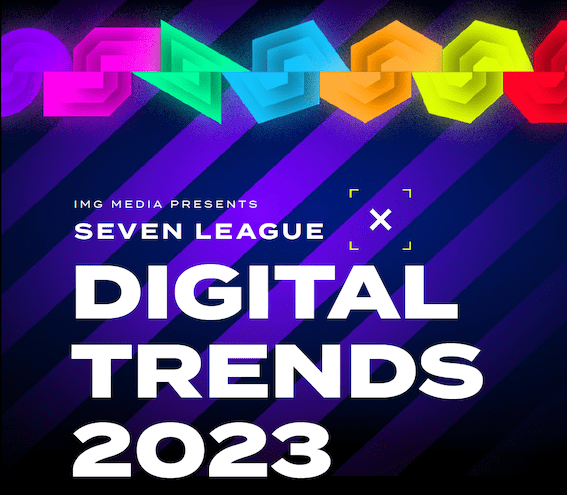At the turn of every year, Seven League releases its digital trends in sports report on the seven key trends to watch for the 12 months ahead. With the world of social media facing challenges and the momentum behind web3 technologies growing ever stronger, might we soon be at a tipping point where social media platforms are replaced as the dominant digital presence? Streaming, content, communities, data and the commercialisation of audience is becoming ever more important. This report pulls out the main themes to look out for and become more familiar with.
Digital trends in sports report 2023 – seven trends to look out for
- Membership wars
The value of live sport to the streaming platforms is clear – sport is a unique driver of audience acquisition (membership subscription) and retention, especially when it’s part of a bundle. Viewership for Amazon’s 2022 streaming-only debut of NFL Thursday Night Football exceeded advertiser expectations and generated a record number of Prime sign-ups during the three-hour window. Sports rights holders need to be able to show the new generation of broadcast partners that they have engaged fan communities which they can bring to the table. Sports will also need to ensure their own membership propositions are premium – with a frictionless user experience and personalisation. - Go big or go different
The same device a sports fan uses to interact with their favourite teams or events is peppering them with alternative options for what to focus on at that very moment – news, music, games, video, retail, and messaging. To avoid becoming diverted by other content and options, there are two main choices: go bigger or go different. Being different means giving your creative teams the freedom and permission to try new ideas and collaborations. Going big means innovation, resource expansion, localising in new global markets and attracting new fans and partners. - Web 3
The early uses of blockchain technology for sports have revolved around collectables – sports fans like collecting and displaying digital assets (cards, highlights clips, skins). It’s likely in 2023 that the innovation won’t be focused on making money but instead to improve the relationship with fans and customers. The true art form is in building and fostering fan communities that connect around these themes. Looking forward it’s thought there will be evolutions in ticketing (proof of attendance backed with digital assets), fan engagement (community building), resaleable digital merchandise and loyalty programmes where fans’ activities are permanently recorded via a digital membership card.
- Artificial intelligence (AI) and the future of content
Sports organisations will experiment by creating immersive 3D content from still images and offering engaging new content for fans on social media. We will see hyper-realistic recreations of famous historical moments from the grainiest archive footage. We’ll see people experimenting with alternative commentary formats that marry live data feeds with AI-generated speech from famous voices. We will see the emergence of a new skill – prompt engineering – where content makers differentiate themselves by knowing exactly which prompt to give the machine in order to get the best result. - Direct-to-consumer (D2C) ≠ DIY
The sports industry will realise that direct-to-consumer (D2C) is not its panacea, it’s an ancillary business line. It will remain extremely important to understand customers better and to grow a rich data picture to help grow multiple lines within the business. The return on investment (ROI) associated with getting better in this area still stacks up, particularly when it concerns event-day revenue. Sport will move to a new paradigm where instead of “going direct” and trying to do everything themselves they will look to stay connected to their customers, while trusted third parties help them navigate D2C, and B2B businesses continue to handle the heavy lifting and write the upfront cheques. There will be gains to be made in the D2C space, but D2C does not equal DIY. Sport will need to carefully consider its supply chain and which bits it is in a good position to own, and which it should outsource. - Sports getting serious about communities
The sports clubs and leagues that succeed will be the ones prepared to deal with the tricky questions that will inevitably arise from giving fans access to official moderators and staff. Fans aren’t wholly unrealistic in their expectations – feeling they’re being listened to and responded to will go a long way to building credit for when on-pitch results turn sour. It’s not a short-term investment but it’s unmatched for the outsized effect it has in creating advocates who will the story for sports organisations, not to mention the unmeasurable lurkers who take part just by reading. - Digital driving women’s sport
Digital will continue to drive the model for women’s sports through the likes of OTT platforms, social channels, NIL (name, image, and likeness) rights, the growth of women’s sport media platforms and sponsorship from brands seeking a direct connection to specific communities. With the FIFA Women’s World Cup approaching in 2023, the conversation around women’s sports will come to the forefront once again with many brands and stakeholders asking what more can be done.
Download the digital trends in sports report 2023
Download the digital trends in sports report 2023 here. For last year’s digital trends in sport 2021 report, click here.
If you’re looking for advice from a sports, esports or gaming agency, Strive Sponsorship can help. Contact us for esports, sports, sponsorship, commercial, content, media, operations, investment, and communications consultancy services.
Frequently asked questions
What trends are currently in the marketing of sports?
2022 trends in sports include investing in NFT propositions, OTT platforms, and building metaverse experiences.
What are the biggest challenges facing the sports industry?
Acquiring, understanding, and monetising first-party data is a growing challenge in the sports industry as commercial pressures grow and traditional revenue stream growth becomes more challenging.
What will be the biggest sports trends in 2023?
Live sport will be used to help acquire subscribers for streaming platforms, sports marketers will get more creative licence to deliver content, web 3 technologies will play a greater role across the industry, AI technologies will increasingly be used in content creation, third party expertise will be utilised to better commercialise consumers directly, fans will start to be seen and interacted with as a community, and digital will continue to be a major driver in the growth of women’s sport.














